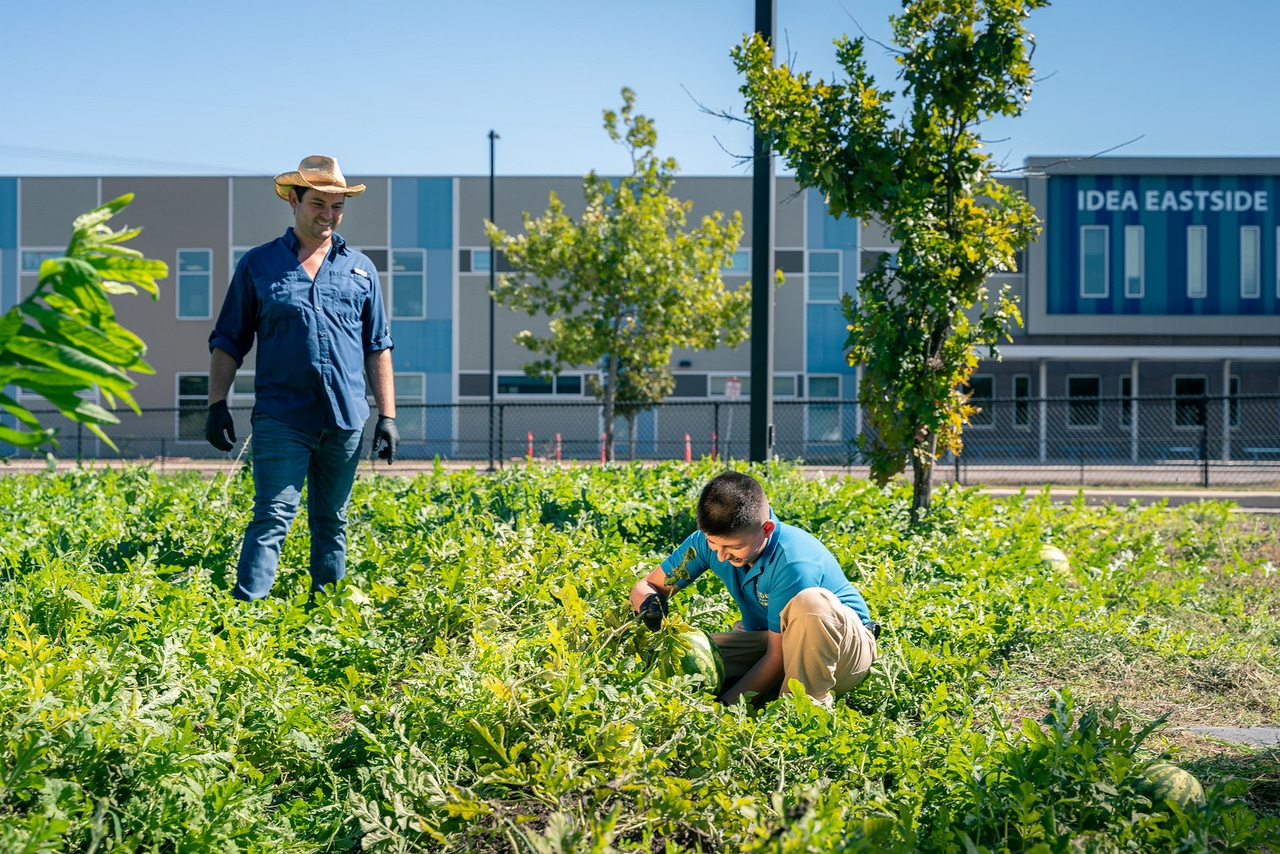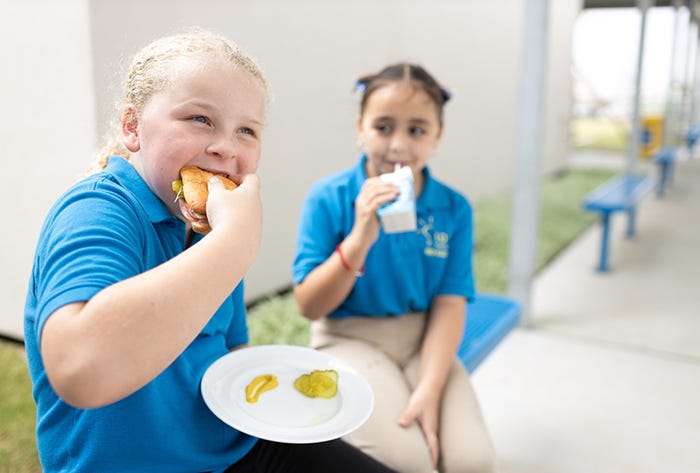A school farm teaches regenerative farming practices—and kids get to eat the resultsA school farm teaches regenerative farming practices—and kids get to eat the results
At IDEA Elsa, a charter school in south Texas, kids grow vegetables next to the playground and gobble them up in the cafeteria.
November 15, 2022

In the summer of 2020, Jordan Roney was hard at work on a half acre of land near the playground at the IDEA Elsa, a K-11 school located near the southern tip of Texas. He spent much of his time building up the soil—heavy clay is common in this part of the country—to create vegetable beds that he and students could use to grow produce for the school’s cafeteria.
Roney had done this before. In 2018, he started work on another garden for IDEA, a charter school program with 143 campuses in four states. At their San Benito campus, located 40 minutes south, Roney established a school farm along with a hydroponic grow box that brims with leafy greens.
Today, the Elsa school farm is in full production, too. A hoop house holds a plant nursery. Three 70-by-50-foot growing fields are organized into rows of vegetables. They also have a pollinator garden, raised beds, a tool shed and an outdoor classroom.
Most foods are grown specifically for the breakfast and lunch menus, Roney says. During the 2021-22 school year, the school farm produced about 19,000 pounds of produce, more than 85,000 servings. The campus of about 1,300 students serves 2,650 meals per day, including breakfast, lunch and supper.
Roney enthuses about the variety of foods he and the students are able to start, tend, harvest and deliver to the campus cafeteria. “We’re fortunate down here in south Texas that we get long growing seasons…and so we grow everything: carrots, broccoli, lettuces, tomatoes, onions. We also plant some fun things for the kids to try, like romanesco and beets.”

Students learn about soil health, plant systems, weather patterns and food systems. They also help with day-to-day production on the farm: preparing beds, starting plants, fertilizing and composting. They also get to taste test the vegetables.
But he’s even more excited about the educational opportunities the farm opens up to students to learn about regenerative farming practices.
Roney teaches sixth and seventh-grade students twice a week for hour-long lessons on soil health, plant systems, weather patterns and food systems. They get hands-on experience, too, helping with day-to-day production on the farm. They work with soil samples, identify parts of plants, prepare beds, start plants, fertilize and compost. A big perk: they also get to taste test the vegetables.
When it comes time to harvest, everyone helps. Students harvest produce, wash it in a triple sink in the farm’s packing shed, sanitize it and load it into wagons for delivery to the cafeteria, which is less than one hundred yards from the farm. Once produce reaches the cafeteria, members of the campus’s 12-person nutrition staff process it.

Students learn about soil health, plant systems, weather patterns and food systems. They also help with day-to-day production on the farm: preparing beds, starting plants, fertilizing and composting. They also get to taste test the vegetables.
Executive chef Daniela Villarreal works at the administrative level, working with a team to develop common menus for schools throughout the IDEA network, including region-specific items.
“Four days a week, everybody has the same thing,” she says. “But one day a week there’s a regional item…Louisiana might have red beans and rice, Florida’s having fish and chips, and Texas is having tamales.”
Part of the menuing process—they roll out a new menu in the fall and another in the spring—is to coordinate with IDEA’s 12 educational farms, which are located across Texas and Louisiana. As they plan menus, Villarreal says, they collaborate with farmers and incorporate produce that the farms are already growing.
“Things that are very common on our menu are zucchini squash, cucumbers, tomatoes, leafy greens, and celery…things they can grow an abundance of and that we know we can use up fast because of the frequency that it shows up on our menus.”
Farm produce might be used to make parmesan carrot fries, white beans and kale, or chicken and vegetable lo mein, all dishes that appear on the November menu.
To help them use their farm’s produce, school cafeterias have some flexibility. Within USDA vegetable subgroups, they can make substitutions based on what’s being harvested. If a farm has a bumper crop of carrots—as the Elsa farm did recently—the cafeteria can replace another red/orange vegetable on the menu with a carrot-based dish, allowing them to use produce right away.
The farm-cafeteria relationship works. But it’s more than a workable system. It’s an integrated program that has the buy-in of students and staff alike.
“I see so much care coming from our staff,” Villarreal says, noting that staff members are genuinely enthusiastic about farm-fresh produce and use it as an opportunity to connect with and educate students. “It really brings everything full circle to the students at Elsa to be able to visit the farm, help put plants in the ground and then [have that food] dished up for them.”
About the Author
You May Also Like





.jpg?width=300&auto=webp&quality=80&disable=upscale)
